As someone who’s passionate about the future of lighting, I’ve witnessed how LED technology reshapes our approach to home and outdoor lighting. Beyond providing energy savings, LED bulbs are hallmarks of sustainability, featuring energy-efficient lighting that champions both the environment and our wallets.
It’s a shift towards eco-friendly production that not only lights our spaces but also enlightens our responsibility to energy conservation. Let me guide you through the transformative world of LEDs, which are rapidly setting new standards for the lighting industry and redefining our energy consumption patterns.
Key Takeaways
- LEDs are at the vanguard of energy-efficient lighting, drastically reducing light energy usage.
- With a significantly longer lifespan than incandescent bulbs, LED technology fosters energy savings.
- Eco-friendly production of LED lights aligns with global sustainability efforts.
- Adopting LED lighting is a sustainable choice for the environmentally conscious consumer.
- The future of lighting is luminous with LEDs leading the path in the lighting industry.
10 LED Lighting Tips to Save Energy Now
Here are 10 LED lighting and energy conservation solutions for your home:
- Replace Incandescent Bulbs with LEDs: LED bulbs use at least 75% less energy and last 25 times longer compared to incandescent lighting. For instance, replacing a 60-watt incandescent bulb with a 10-watt LED can save about $125 over the bulb’s lifetime.
- Use Dimmer Switches: Dimmers reduce energy consumption by lowering light levels. A dimmer switch can save up to 40% in electricity over a bulb’s lifetime and extend the life of the bulb.
- Install Motion Sensors: Motion sensors turn lights off when rooms are unoccupied. They can reduce lighting costs by 30% by ensuring lights aren’t left on unnecessarily.
- Opt for LED Task Lighting: Instead of brightly lighting an entire room, focus on the areas where you need it. For reading or cooking, an LED task light can reduce overall energy use.
- Upgrade to LED Outdoor Lighting: LED outdoor lights are more energy-efficient and durable. Solar-powered LED outdoor lights are even more energy-efficient as they rely on renewable solar energy.
- Adopt Smart Lighting Systems: Smart bulbs can be controlled remotely to turn off when not needed. Some systems offer scheduling features, which can reduce wasted energy.
- Choose ENERGY STAR® Rated LEDs: These LEDs meet strict efficiency, quality, and lifetime criteria. An ENERGY STAR certified light bulb uses about 70-90% less energy than traditional incandescent bulbs.
- Implement Daylighting: Use natural light wherever possible. Arrange workspaces near windows and choose light-colored curtains that allow daylight to penetrate the room while maintaining privacy.
- Optimize Holiday Lighting: Use LED string lights for holiday decorations. They use less electricity and are cooler, reducing the risk of fire hazards.
- Regular Maintenance: Dust your light bulbs and fixtures regularly. Clean bulbs provide more light and therefore, you can achieve the same level of brightness with lower energy output.
Each of these solutions not only helps conserve energy but also contributes to reducing your overall electricity costs. Adopting LED and smart lighting technologies is a significant step towards a more energy-efficient and environmentally friendly home.
Avista: Switching to LED lighting, which uses 85% less energy than incandescent bulbs and lasts up to 10 times longer, is an easy way to start saving energy. Additional savings can be achieved by using motion sensors to automatically turn off lights, setting timers for lights when away, and utilizing natural light.
Benefiting from the Extended Lifespan of LED Lights
As I delve deeper into the transformative impact of LED technology on our daily lives, one cannot ignore a fact that stands out—the impressive longevity of LED lights. It’s through this extended lifespan that LED lights last much longer than their traditional counterparts, translating into substantial maintenance savings and a significant reduction in the frequency of replacements required. We’re talking about operational times that can surpass 100,000 hours, a feat that positions commercial energy efficient lighting as a formidable player in the quest for sustainability.
For individuals and businesses throughout the United States, the transition to LED lighting isn’t just an environmentally conscious shift— it’s a financially savvy one. The robust nature of these bulbs ensures that efficient lighting doesn’t come at the expense of durability. Indeed, the savings in the United States accrued from making the switch to LEDs is anything but marginal. It’s stories like these that spotlight the profound advantages of led lights and why they are becoming a standard for energy-efficient led solutions in diverse settings.
- The longevity of LEDs means fewer purchases over time— a win for your wallet and the environment.
- With quality that outshines the rest, higher-grade LEDs push normal standards, offering even longer lifespans.
- From streetlights to home fixtures, LEDs prove their worth, grounding their status as the preeminent choice in lighting technology.
One cannot overstate the ripple effect of these maintenance savings across the broader economic landscape. With anecdotes and case studies pouring in from across the nation, it’s clear that LEDs are not just a product but a significant shift in our approach to energy utilization and conservation. LED lights are leading us toward a brighter, more sustainable future, and I’m here for it.
Maximizing Space with the Compact Size of LED Lighting
We’re living in an era where creativity harmonizes with technology to offer remarkable solutions for lighting. When it comes to illuminating tight quarters, LEDs have outshone traditional options like compact fluorescent lights (CFLs) due to their minuscule size. These tiny powerhouses slide effortlessly into challenging narrow spaces, bringing light to every crevice of your home or office that once lay dim.
Homeowners and designers, rejoice! Gone are the days when bulky fixtures forced your hand—LED lighting not only equips you for an array of task lighting needs but also cranks up the notch on design flexibility. It’s a canvas of possibilities for the artist in you, waiting to paint light in every stroke of your domestic or commercial tapestry.
Application in Narrow Spaces
The mastery of LEDs doesn’t end with their space-saving form. These indoor low energy lights illuminate under-cabinet kitchens, the insides of drawers, and even the often-forgotten nooks behind furniture. And, it’s not just about getting the job done—LEDs offer the grace of a ballerina with performance that packs a punch, locking in on the exact locales without overwhelming adjacent areas.
Creative Design Possibilities
The true spice of customizable illumination comes alive with LED. Energy-efficient lighting technologies emerge as both the hero and the muse in creating ambiances that range from warm, cozy corners to vibrant, energetic workspaces. The concoction of design flexibility and the LED’s ability to merge into the environment makes it the perfect ingredient for creative lighting solutions that resonate with function and form.
- The compact size of LEDs revolutionizes indoor lighting by fitting into the snuggest spots.
- Task lighting gets a futuristic twist with low energy LEDs shining bright where you need them the most.
- LEDs bring forth an era of customizable illumination, weaving energy efficiency into the fabric of creative designs.
LED Lighting and Energy Conservation: Utilizing Directional Light
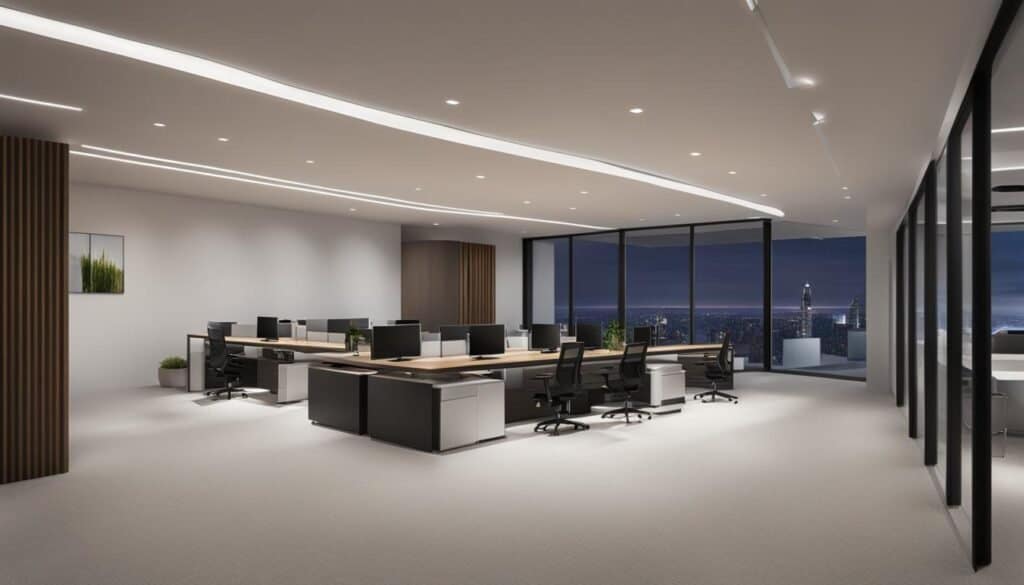
When I think of the monumental shifts in lighting technology, it’s the ability of LEDs to emit light in a specific direction that truly exemplifies their value in energy conservation. This feature enables precise lighting that aligns perfectly with our need to focus on sustainability while reaping all the practical benefits.
This unique directional capacity of LED lighting systems has a palpable impact on energy efficiency, especially when compared to the diffuse nature of traditional lighting. In this section, I’ll discuss how LEDs emit light in a specific direction and illuminate the advantages of this for both the environment and our living spaces.
Reduction in Light Wastage
Think about the traditional lighting fixtures we grew up with: light scattering in all directions, often illuminating spaces unnecessarily. With LEDs, that’s a thing of the past. These energy-efficient and rapidly-developing lighting technologies have honed the skill of precision, targeting light right where we need it, and nowhere we don’t. This focused approach to lighting is ideal not only for costly commercial areas but also our cherished home environments.
Enhancing Area-Specific Illumination
And when we talk area-specific, let’s consider recessed downlights and task lighting. These are areas where LEDs truly shine, both literally and figuratively. With quality LED light bulbs that have mastered the art of directionality, these lighting applications don’t just brighten a space; they enhance its aesthetic, functionality, and energy efficiency.
| LED Lighting Area | Advantages | Lifetime Hours | Energy Savings |
|---|---|---|---|
| Recessed Downlights | Direct illumination with minimal wastage | 50,000+ | Up to 75% |
| Task Lighting | Localized lighting with enhanced clarity | 50,000+ | Up to 85% |
| General Room Lighting | Even distribution without lighting unused areas | 50,000+ | Up to 80% |
| Accent Lighting | Highlighting specific features or decor | 50,000+ | Up to 75% |
Exploring the terrain of modern lighting has revealed just how adaptable and intentional LED technology can be. It’s not just about being an energy star rated product; it’s about the harmony between form, function, and conservation. That’s the true essence of what it means to bring light into our lives while taking care of our planet. As consumers and citizens, we have at our fingertips, quite luminously, the power to choose LED lighting products that reflect both our aesthetic desires and our environmental responsibilities.
Enhancing Durability with Solid State LED Lights
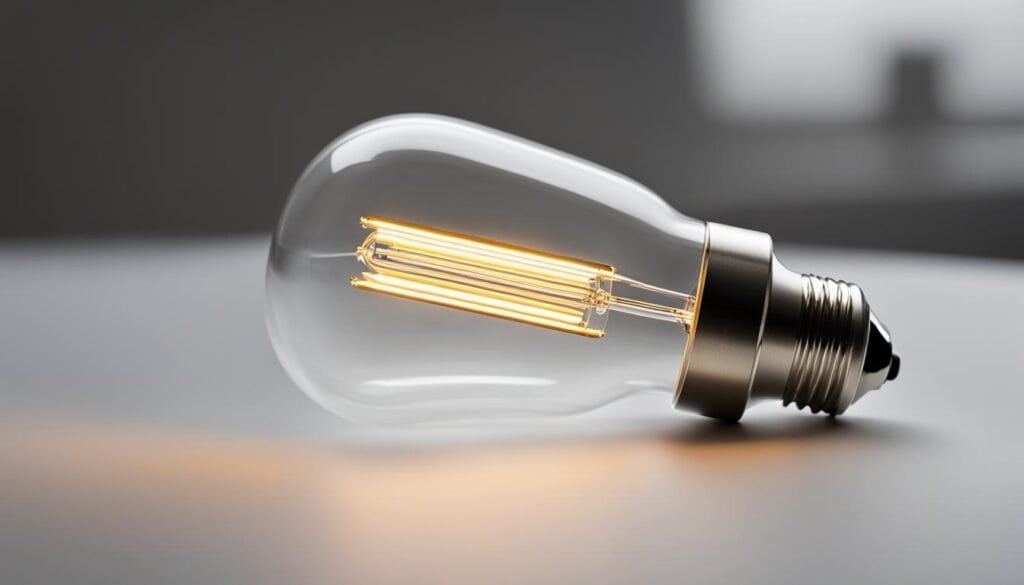
As I delve into the robust world of solid state lights, I can’t help but marvel at their transformative power in the lighting industry. Unlike traditional lighting, which is often encased in breakable glass, LEDs are solid state lights known for their ruggedness. This intrinsic durability of LED lighting is a beacon for both the energy-conscious user and the environmentally aware consumer, signaling a move to more durable lights with impressively long lifespan.
In industrial settings, the resilience of LED lights can’t be overstated. Industrial lighting demands reliability, and LEDs stand up to the challenge, requiring less maintenance thanks to their longevity of lighting products. For me, it’s clear that the shift toward solid state LEDs isn’t just about enduring luminosity; it’s about embracing a future where cost savings and environmental stewardship go hand in hand.
Consider the numbers: LEDs consume less energy than incandescent bulbs, thus offering reduced electricity costs, which make a real difference to the bottom line, particularly when scaled across large facilities. This energy conservation translates directly into not only monetary but also ecological benefits, positioning energy-efficient lighting as the front-runner in sustainable practices for businesses and homeowners alike.
| Characteristic | Impact of Solid State LEDs |
|---|---|
| Robustness | Increases longevity and reduces breakage likelihood |
| Energy Consumption | Requires less energy, resulting in reduced operating expenses |
| Maintenance Needs | Lower frequency of replacements, leading to maintenance savings |
| Environmental Benefits | Contributes to lower carbon footprint and sustainable resource use |
The journey through the world of LED technology has been enlightening. It’s become clear to me that embarking on the path of using solid state LED lights is not only a wise choice but a necessary one for those seeking to optimize their lighting solutions both financially and environmentally. In summary, my exploration confirms that LEDs represent the pinnacle of durable, cost-effective, and energy-efficient lighting.
Improving Air Quality and Safety: The Low Heat Emission of LED Lights
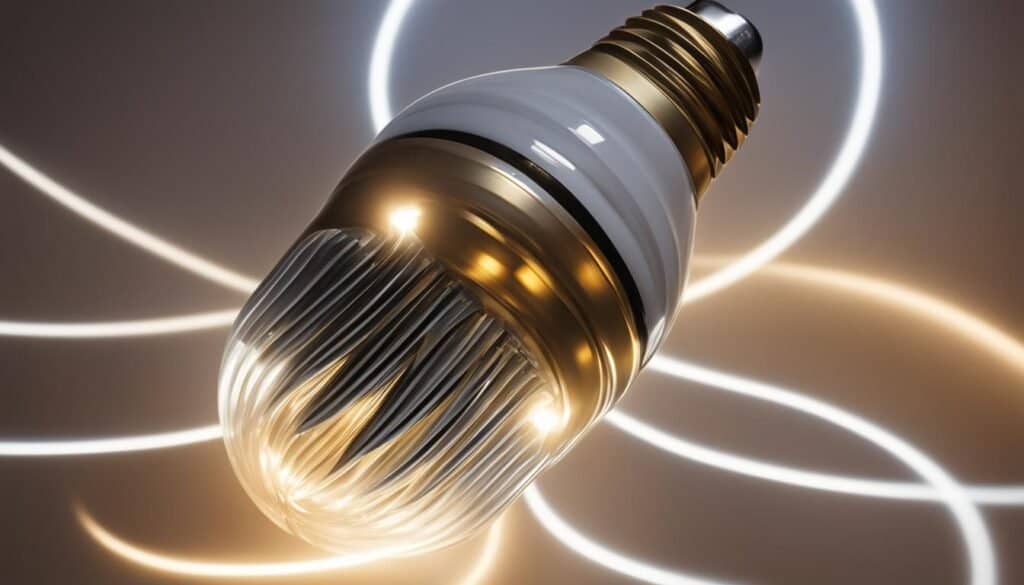
As I explore the myriad benefits of LED technology, a notable advantage that comes to light is the low heat emission of these bulbs. Embracing LED lights, which are energy efficient and emit very little heat, leads to safer lighting solutions both at work and at home. The considerable reduction in heat emission contributes not only to better air quality but also to cooling cost savings—offering relief to our air conditioning systems and our energy bills alike.
Safer Work and Home Environments
LEDs significantly enhance the safety of our environments, emitting so little heat that the risk of burns or fire is markedly decreased. This safer operation, inherent in efficient LED lighting, offers peace of mind, especially in settings where we spend considerable hours. It’s not just about the bright light; it’s about creating a safer space for children playing, professionals working, and every family member going about their daily routines.
Reduced Risk of Overheating and Fire
In my time assessing the benefits of different lighting technologies, the superior fire safety with LED lighting stands out distinctively. Reduced risk of overheating translates to a lower chance of fire hazards—a significant advantage for any setting. Additional to increasing our spaces’ safety, this attribute of LED lights puts less strain on power plants, allowing them to operate more efficiently, thereby aiding in the reduction of global emissions. It is reflective of the roles we can play, through informed choices, in promoting a safer and more responsible future for our planet.
My firsthand experiences with LED lights continuously reveal how these efficient lighting solutions smartly reduce heat emission. This not only safeguards our homes and workplaces but also implies broader ecological implications—less energy use leads to fewer emissions from power plants, contributing to the global fight against climate change. Truly, adopting LED technology is one of the most straightforward actions we can take for both our immediate safety and the long-term health of our environment.
Intelligent Energy Use: The Advantages of Dimmable LED Lights
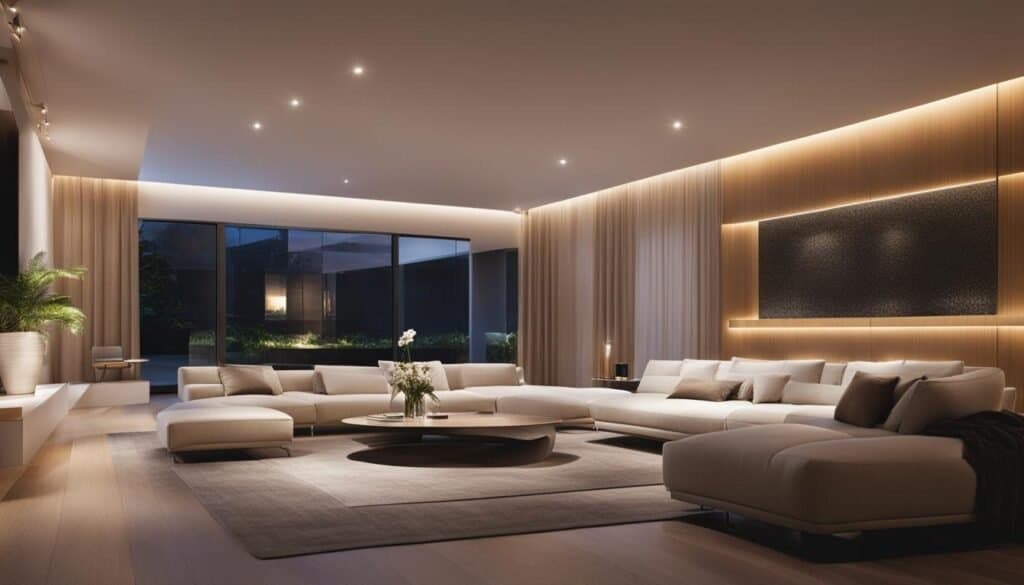
Embarking on a journey through the electrifying world of lighting innovation, I’ve been captivated by the smart functionality of dimmable LED lights. The ability to customize the ambiance of any room with adjustable brightness isn’t just a convenience; it’s a testament to the advancements in LED technology and its commitment to energy savings and efficient lighting. It’s this versatility of handling variable energy inputs that makes dimmable LEDs such an intelligent addition to modern residential lighting.
Not only do these innovative fixtures shine brightly in terms of low power operation, but they also offer the potential to save a lot less energy when dimmed – a feature non-existent in standard incandescent bulbs. It’s a delightful feature that allows us to shape the atmosphere of our homes while simultaneously contributing to a greener planet. As I continue to explore the benefits of dimming, I’ve found that it does wonders to enhance the lifespan of lights too, providing a level of significant energy savings that can’t be overstated.
| Feature | Advantages of Dimmable LED Lights |
|---|---|
| Energy Efficiency | Saves up to 80% more energy than traditional lighting |
| Adjustable Brightness | Personalize lighting to suit different times of day and moods |
| Lifespan Extension | Dimming can increase longevity, reducing the need for frequent replacements |
| Low Power Operation | Operates efficiently at lower wattages, reducing electricity consumption |
In my experience, these dimmable marvels are more than just a trend; they’re an integral part of a future where energy conservation goes hand-in-hand with sophisticated residential living. Their role in sustainable living is underscored by a collective desire for LED technology that not only provides comfort and style but also echoes our commitment to environmental stewardship. Trust me, integrating dimmable LED lights into your home is not just a bright idea—it’s a smart, energy-wise move that paves the way for significant energy savings and a lighter carbon footprint.
The Superior Color Rendering Index of LEDs
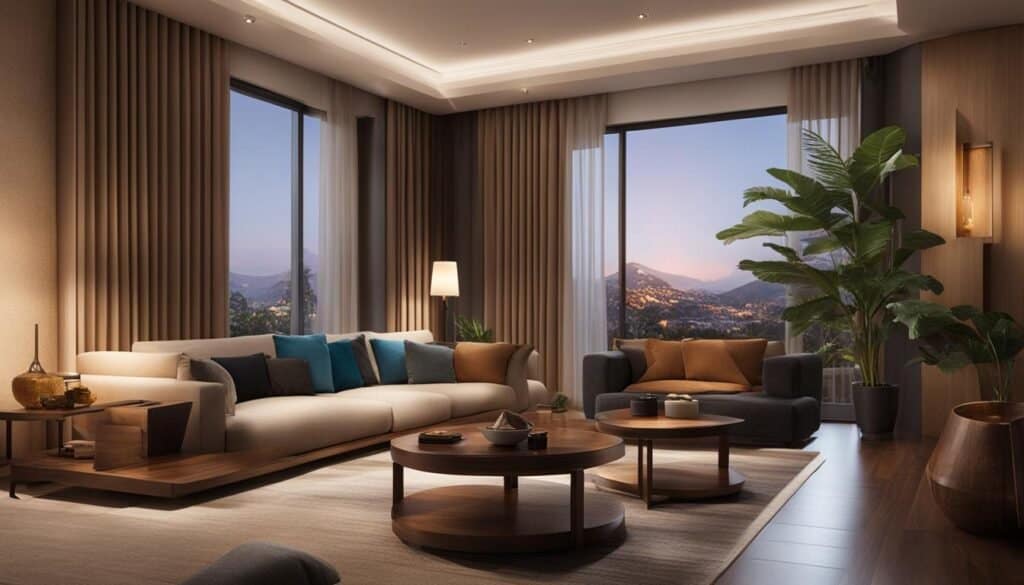
In my pursuit of understanding how light shapes our perception, I’ve come to appreciate the unparalleled capabilities of LEDs and their high Color Rendering Index (CRI). With their ability to provide visualization and illumination that closely mimics natural light, LED lights stand out in their superior delivery of accurate color representation.
Visual Clarity and Accuracy
Imagine a world where colors are vivid and true to life, where you can see the subtleties and hues as they are meant to be – this is the reality offered by LED technology. Enhanced perception is a key benefit, as led lights have a higher CRI compared to other lighting options. This means that whether it’s for a commercial gallery or a cozy reading nook at home, the colors are rich and the details are clear.
Impact on Perceived Brightness
It’s not just about authentic color; it’s also about how light influences our perception of space. With brightness control, LEDs offer clearer and brightly lit environments without being harsh. This is of particular importance in commercial spaces lighting, where creating the right ambiance can enhance customer experience and lead to better engagement with the space. The energy-efficient illumination provided by LEDs also affirms their role in sustainability.
Considering the impact of LEDs’ color accuracy extends beyond mere aesthetics; it’s about rendering a space where everyone – from artists to architects – can trust that the lighting options available are contributing to a true-to-life visual experience. It extends into everyday moments, illuminating everything with a brilliance that is pure and precise.
| Lighting Feature | Benefit for Users | Applications |
|---|---|---|
| High CRI | Accurate color perception, improved visual clarity | Art studios, retail, home interiors |
| Brightness Control | Adjustable illumination to suit ambiance and mood | Restaurants, galleries, living spaces |
| Energy-efficient | Reduced energy consumption for sustainability | Offices, commercial buildings, public spaces |
As I reflect on the transformation that LED lighting has brought into our lives, it’s clear that this technology is not just an upgrade, but a necessary step towards better illumination everywhere. With the myriad benefits they bring to both aesthetics and functionality, it’s no wonder that the choice for LED lighting is shining brighter than ever.
Conclusion on Led Lighting and Energy Conservation
Throughout our exploration of the transformative nature of LED lighting, it has become evident that the benefits of LED lights go beyond mere illumination. They represent an evolution in how we perceive and interact with light itself. Embracing these innovative lighting solutions is not just a bright idea; it’s a commitment to a future where energy costs and savings are inextricably linked with our environmental aspirations. My journey into the heart of LED technology has reaffirmed my belief that these lights, with their promise of led light energy conservation and eco-friendly production, are the beacons guiding us towards a sustainable lighting future.
As I reflect on the long-term savings garnered from reduced maintenance needs and lower energy bills, I realize the impact is profound. Not only do these savings bolster our economic stability, but the maintenance savings and reduced carbon footprint of LED lighting also reflect a smarter, more responsible way of living. It’s clear that making smart lighting choices today, like opting for energy star products, positions us on a path to a brighter and greener tomorrow.
By choosing to adopt LED technology, each one of us contributes to the global switch to LED—an integral step in reducing our collective carbon footprint. The narrative is clear: a switch to LED is not just about adopting new technology; it is a powerful statement of our dedication to energy conservation and a testimony to the positive impact we can have on this planet. I am inspired by the progress made thus far and encourage others to embark on this journey towards a luminous and sustainable lighting future.
FAQ on Energy Efficiency LED Products
Q: What are the energy savings benefits of using LED lights?
A: LED lights can provide significant energy savings over traditional incandescent bulbs. According to the Department of Energy, LED lights use at least 75% less energy than conventional light sources, offering potential for substantial reduction in energy consumption for lighting. Energy savings in the United States can be substantial because of the widespread use of LED lighting. Additionally, with their long lifespan, LED lights can last up to 25 times longer than incandescent lighting, providing even more savings.
Q: How do LED lights work and what makes them more energy-efficient?
A: LED lights work by using a semiconductor to convert energy into light, unlike an incandescent light bulb which produces light by heating a filament until it glows. This means that LED lights do not waste energy as heat, making them much more energy-efficient. The light emitting diodes (LEDs) are also adjustable giving an edge over other types of lighting like fluorescent or CFLs in terms of light quality and directionality.
Q: What are the benefits of replacing my home lighting with LED bulbs?
A: Switching to LED bulbs for home lighting has many benefits. First, they are more energy efficient as they produce more light energy per watt compared to traditional incandescent bulbs. Second, due to their energy efficiency, LED lights can reduce annual energy consumption and help you save on energy and money. They last longer, reducing the frequency of replacements. LED lights also offer better light quality, enhancing home ambiance.
Q: How does the use of LED lights contribute to energy conservation?
A: As LED lights use less energy and last longer than traditional lighting options, they significantly reduce energy consumption. They cut down on the need to manufacture, transport and dispose of lamps, contributing to energy conservation. Moreover, as lighting accounts for a considerable percentage of energy use worldwide, widespread use of LED lighting can significantly lower global energy demand.
Q: What are some energy saving tips related to LED lights usage?
A: To maximize energy savings with LED lights, consider switching all of your most frequently used light fixtures or bulbs at home. Always look for ENERGY STAR-rated products as they are more energy efficient and offer better light quality. If applicable, use lighting controls, like occupancy sensors or timers, that will minimize LED lights use when not needed. Lastly, ensure that you choose the right light source suitable for your intended use to avoid over-lighting which can lead to energy wastage.
Q: What different types of LED lights are available for home lighting?
A: There are various types of LED lights available for home lighting. These include spotlights and downlights which are suitable for task lighting, LED bulbs that can be used in most common household light fixtures, LED strips for decorative lighting, and outdoor LED solutions such as pathway lights and security lights. It’s important to choose the right type of LED light to suit your specific requirements.
Q: What is the light quality provided by LED lights?
A: LED lights can provide excellent light quality. They give off light in a specific direction, reducing the need for reflectors and diffusers. With advances in technology, LED lights can now replicate the warm glow traditionally achieved by incandescent bulbs. Also, they are available in various color temperatures for different lighting moods. They also don’t flicker and start at full brightness as soon as they are switched on.
Q: How long can LED lights last?
A: LED lights have a significantly longer lifespan in comparison to other light source. Depending on the quality, usage and the conditions in which they are used, LED lights can last anywhere from 25,000 to 50,000 hours. This is much longer than incandescent lighting or fluorescent bulbs, reducing the costs associated with replacement and maintenance.
Q: Are LED lights only used for energy savings? What are other benefits?
A: While energy savings is a primary benefit of LED lights, there are other advantages as well. Due to their compact size, LED lights allow for flexibility in designing lighting fixtures and positioning lights. They produce less heat than conventional lighting solutions which makes them safer to use in various environments. LED lights also offer better light quality, helping to create desired ambiances. Their longer lifespan also reduces replacement hassles.
Q: Why have LED lights become so popular for energy conservation?
A: LED lights have become popular due mainly to their energy efficiency and long lifespan. The ability of LEDs to generate the same amount of light as traditional incandescent bulbs while using less energy has made them a preferred choice for those looking to conserve energy and decrease power bills. Owing to these features, LED lighting solutions are deemed a practical step towards sustainable living and energy conservation.

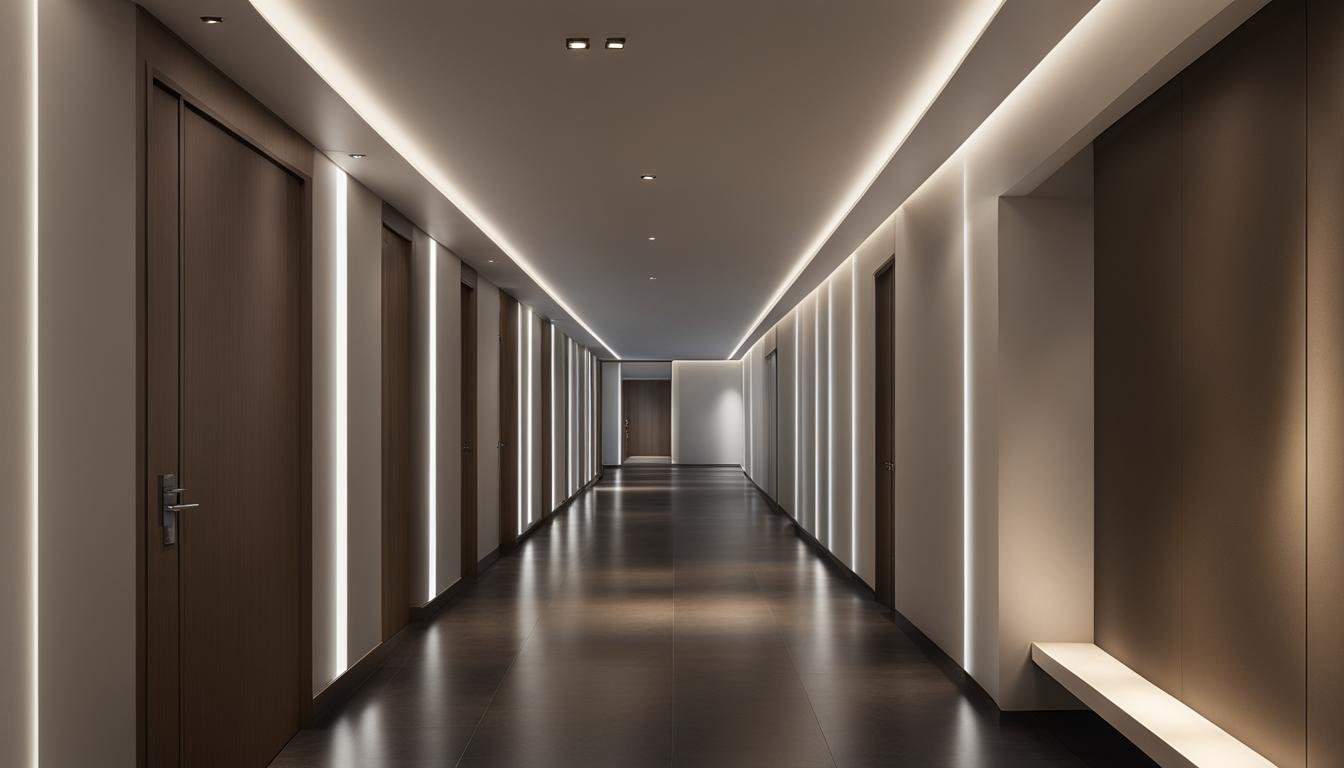



Leave a Reply